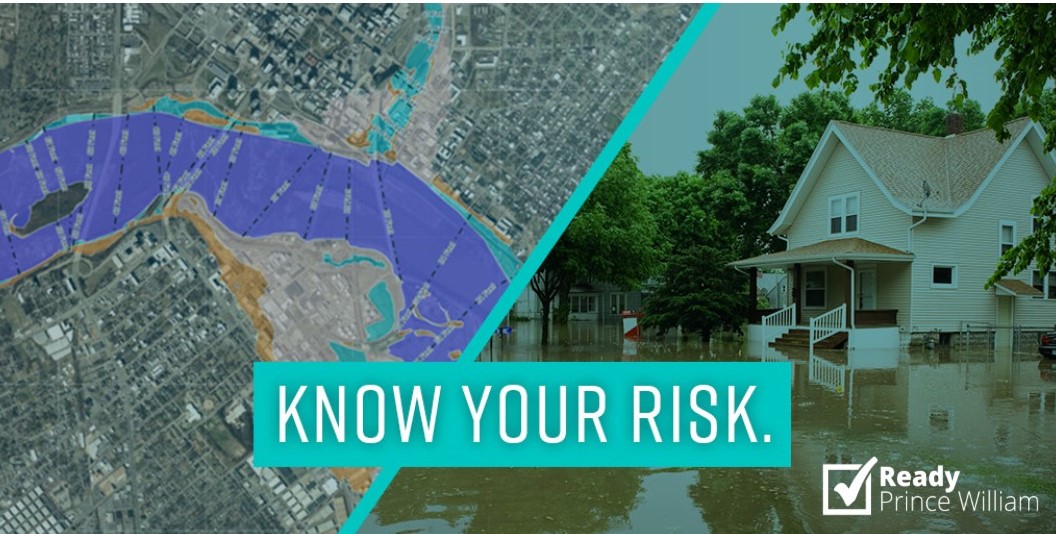Skip to content
Flooding

FLOODING IS THE MOST COMMON HAZARD FACING PRINCE WILLIAM COUNTY AND ALL OF VIRGINIA.
FREQUENTLY ASKED QUESTION'S
- What is my flood risk?
- Flooding is the #1 hazard in Prince William County! Anywhere it rains, it can flood. People living in low-lying areas, near water or downstream from a dam are at particular risk. You can find out what your personal flood risk is through this link. Make sure you check addresses of places you frequently go to like school, work, or houses of worship.
- Are floods predictable?
- Sometimes, it depends on the cause of the flood. However most of the time we can see flood conditions forming and can alert the public. You can get alerts to flood watches and warnings through our emergency alert app here.
- Are floods dangerous?
- Yes, flooding is various dangerous. It takes just 6 inches of moving water to sweep you off your feet! It only takes 12 inches of moving water to move your car. Flooding is the 2nd cause of death in weather fatalities!
- Is flooding covered under my homeowners or renter's insurance?
- Flooding is not covered by homeowners or renter's insurance! You must purchase flood insurance separately to get coverage. Prince William County participates in the National Flood Insurance Program, which means all residents are eligible for flood insurance, even if you don't live in a high-risk flood zone.
- How will I know if flooding is occurring?
- Sign up for emergency alerts here to get notified if there is a flood watch or warning!
- How much will flood damage cost me?
- Food damage can cause up to $27,000 in damage! Use the tool below to see how much one inch of water can cost you depending on the size of your home.
TERMINOLOGY
- Flood Watch- Be prepared, conditions are present which could lead to flooding.
- Flood Warning- Flooding is imminent or occurring. Seek shelter.
- Flash Flood- A flood caused by heavy rainfall in a short period of time, many times the cause is thunderstorms.
- Floodplain- An area of low-lying ground adjacent to a body of water that is subject to flooding.
- 100 Year Floodplain- A 100 year flood plain is an area that has a 1-in-4 chance of flooding at least once in 25 years.
BE PREPARED
BEFORE
- Build a Kit- Click here to learn how to build an all hazards emergency kit. Waterproof containers and waterproof phone bags are items you should have in your kit to keep your stuff dry and clean through flooding.
- Sign up for PWC Alerts here to get alerts when flood watches or warnings are in place.
- Find out if your home, business, house of worship, or other frequently visited location is in a floodplain with FEMAs flood map here.
- Make a plan to stay in contact with your family. Here is a template to help you!
- Bring in outdoor furniture and move important indoor items to the highest possible floor.
- Disconnect electrical appliances and do not touch electrical equipment if you are standing in water.
- If instructed, turn off your gas and electricity at the main switch or valve.
- Purchase flood insurance! Just 1 inch of water can cause upwards of $25,000 in damages. Click here to find more about the National Flood Insurance Program. If you have some questions check out our flood insurance page.
DURING
- If in a Vehicle:
- Turn Around Don't Drown!® DO NOT attempt to cross flowing water, and never drive through flooded roadways. Just 12 inches of moving water can carry a small car, 18 inches can move larger vehicles.
- Drive to higher ground.
- Evacuate if directed.
- Activate your family emergency plan and follow your procedures for family reunification and communication.
- If in your Home:
- Get to the highest level of your home with your emergency kit.
- If told to evacuate prepare to leave your home.
- Activate your family emergency plan and follow your procedures for family reunification and communication.
AFTER
- Return home only when authorities say it is safe.
- Be aware of areas where floodwater has receded and watch out for debris
- Do not attempt to drive through areas that are still flooded, there can be hidden debris under the water.
- Avoid standing water as it may be electrically charged from underground or downed power lines
- Photograph damaged property for insurance purposes.
- Follow your family communication plan and use social media and texting to connect with family.
- Wear personal protective clothing and discard any contaminated items.
For more information about flooding and dam safety go to our Flood and Dam Safety Page.